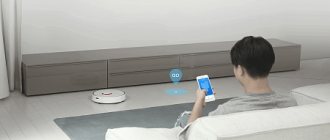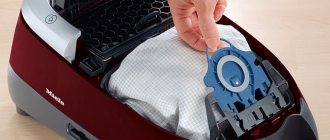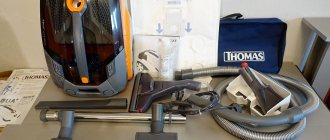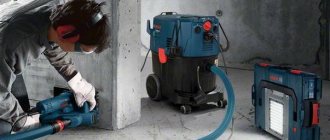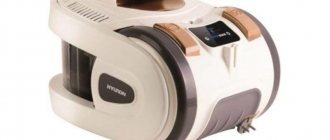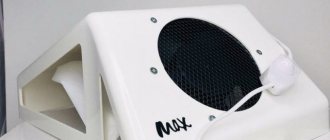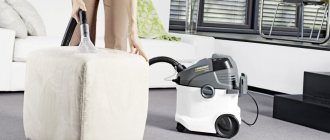Even if you have a lot of free time, turning off the vacuum cleaner while cleaning is very annoying. This can be confirmed by all owners who have at least once had to finish cleaning with a broom and dustpan. If you notice that the body of the vacuum cleaner gets very hot, after which the device turns off and refuses to work until it cools down completely, it is important to correctly determine the reason why this is happening. To make it easier to understand, you first need to understand the principle of operation of vacuum cleaners.
The electric motor is the heart of the vacuum cleaner
All vacuum cleaners have a motor that works by connecting to an electrical outlet or using a battery. The principle of operation of a household appliance is very simple: an electric motor rotates a vacuum turbine, creating a vacuum inside the working chamber. The air tends to fill it and is directed through a hose with various attachments to a bag or container, taking with it dust and small debris. There they remain, and the air, having passed through an additional filter, is directed through the motor windings or turbine, filtered again and released back into the room.
Electric motors can have different designs. In vacuum cleaners for dry cleaning, direct-flow motors are most often used, in which air passes through the motor windings. If the model is intended for wet cleaning, this design is not suitable: there is a risk of water droplets getting on the windings, so bypass motors are used. With them, the intake air does not come into contact with the electrical part, but is directed through the turbine, bypassing the engine. This creates difficulties with cooling the motor, so the design is supplemented with another impeller, which is located in the upper part of the engine.
Vacuum cleaner motors also differ in the number of vacuum stages. Simple vacuum cleaners have only one level, which allows you to create maximum air flow, but the degree of vacuuming is not too high. Two- and three-stage vacuum cleaners create a more powerful vacuum, but they have a lower air flow rate.
Why does the device heat up quickly? Possible reasons
Normally, the electric motor heats up during operation and is immediately cooled by the air flow. At the same time, it is possible to maintain a fairly stable temperature. But if something doesn't work as intended, the vacuum cleaner starts to get very hot. To prevent the motor from burning out, protection is activated.
Constant overheating, even not too much, poses a danger to vacuum cleaners. The problem is that the impellers of fans and turbines in many models are made of plastic. It is lightweight, can take any shape, and is quite cheap. However, there is also a minus - the ability to deform when heated. If the impeller is deformed, gaps appear that do not allow a sufficiently strong vacuum to be created in the device.
Residual shutdown system
The protective shutdown of the vacuum cleaner occurs thanks to a special sensor. If the temperature exceeds a certain value, the circuit opens. To prevent owners from trying to ignore the problem, the shutdown sensors have hysteresis - this is the name of the delay between turning off and turning on the motor, based on the temperature difference. Until the vacuum cleaner cools down to a certain point, the protective system will not allow it to be turned on. If not for this, the motor could have burned out.
Interturn short circuit of windings
This problem sometimes happens with straight-through vacuum cleaners if inattentive owners suck up spilled water or drinks from the floor with dry vacuum cleaners. Contact between water and electricity always leads to sad consequences, usually irreversible. In this case, the motor is replaced, and the operation of the vacuum cleaner is restored.
Poor engine ventilation
In this situation, the shutdown occurs due to the activation of the protective system. And heating occurs due to the fact that the motor works with increased load. For models with an additional impeller, the problem may be caused by the impeller being jammed or deformed.
Worn brushes
In this case, the power of the motor itself is reduced. Replacing the carbon brushes can help if you can find suitable spare parts. It is not recommended to carry out this operation without experience; it is better to turn to professionals.
Filling of bag or container
The vacuum cleaner tries to pass air through itself as usual, but a clogged dust container does not allow this to happen. Having discovered that the equipment does not suck in debris, the owners try to turn on a higher speed, and the motor begins to heat up even faster. The problem can be solved by emptying the trash bag or container.
Clogged hose or pipe
This problem very often leads to overheating or even burnout of the motor, reducing the service life of vacuum cleaners of any type. But dealing with it is not as difficult as it might seem. First you need to disassemble the telescopic handle. Its parts are visible to the light; if the light is not visible on the straight section, you just need to push the plug out with a long thin object. Convenient to use wire. Be sure to check the bends in the area where the nozzles and handles are attached - this is where the air flow changes direction, and conditions for clogging the lumen are created. If everything is fine with the handle, disconnect the hose from the body and also inspect it for debris plugs. It is recommended to perform the procedure even with a slight decrease in power, without waiting for the device to overheat.
Why does the LG vacuum cleaner heat up and turn off?
Heating of the vacuum cleaner body during operation (with possible shutdowns before cooling) is an important indicator of a malfunction in the mechanism. Sooner or later, this behavior will inevitably lead to breakdown of the entire device. Therefore, engine heating cannot be ignored; diagnostics should be carried out as quickly as possible and a decision on further actions should be made.
Diagnostics
In order to identify the cause of the case heating, it is recommended to use the method of elimination:
- Turn on the vacuum cleaner with the hose disconnected - if the body stops heating, then the problem lies in the hose itself or its nozzle.
- If the device continues to heat up, then an external inspection of the inlet hole is carried out for the presence of foreign objects or large debris.
- Remove the dust container and turn on the vacuum cleaner. If the electric motor stops heating up, then the problem is that the bag is full.
- Clean or change filters.
On average, the HEPA filter requires replacement once every six months or after 50 hours of continuous operation of the vacuum cleaner.
If, after passing the diagnostics, the housing continues to heat up, the main reason must be sought in the operation of the motor itself. In this case, there are two options: with a certain skill, the user can independently fix the breakdown. However, most often this kind of malfunction requires service intervention.
Solution
After identifying the reasons for the engine heating during operation of the vacuum cleaner, it is necessary to begin eliminating them:
- Dirty filter. During operation of the vacuum cleaner, a large amount of debris and dust from the sucked air constantly accumulates on the surface of the filter. This kind of contamination reduces throughput and negatively affects the engine, increasing loads and leading to overheating. Therefore, the filtration system needs to be systematically replaced and cleaned. In this case, the possibility of having several filters in one device (at the air inlet and at the air outlet) should be taken into account.
- Overflowing garbage bin. A bag completely filled with debris and dust becomes a real obstacle to air flow. Some models are equipped with an automatic system to turn off the device if the dust container is full, however, even they do not always work. Therefore, each user must check the fill level independently from time to time. If a reusable bag is used, it should be washed periodically, since even after shaking out, a large amount of fine dust remains in the fabric. The dust collector can be reinstalled after washing only after it has completely dried.
- Failure of components or individual engine elements. In this case, it is recommended that only people who have already had experience in such work undertake repairing the engine. Since the cause can be a breakdown of any of the existing parts, and also taking into account the metal of the body (aluminum is most often used, which is easily deformed), attempts to repair the vacuum cleaner can lead to its final failure or even greater damage. Therefore, it is better to immediately contact the service center specialists.
Troubleshooting solutions
For whatever reason, the vacuum cleaner turns off, the owners have three options:
- read reviews on forums and try to put the equipment in order yourself;
- contact a service center or a good repairman found through friends;
- buy a new vacuum cleaner.
The first option is good if the warranty period has long expired, so you won’t be too upset if you completely break your vacuum cleaner. The second case is for models with low wear. Those that are under warranty must be serviced at a service center. The third option will be the best solution if your equipment cannot be repaired, is very worn out, or requires a very large investment.
What to do in case of breakdown
If your Philips vacuum cleaner won't turn on, you should first diagnose it and fix it yourself whenever possible. If the equipment does not start, it is better to take it to a service center and entrust it to specialists. It is not worth disassembling or repairing it yourself.
Step-by-step diagnostics of a possible malfunction
Self-diagnosis can be done at home. It will allow you to understand why the vacuum cleaner broke down and what to do with it. Diagnostics takes place in several stages:
- You need to start by checking the outlet: is the plug turned on, is there electricity. It's worth trying to switch the equipment to a different outlet. It is recommended to constantly check that the cord is intact before turning it on.
- Then turn off the device and check the power cord and plug: they should be in order, not twisted or frayed.
- Then it’s the turn of the hose with the nozzle. If an object gets inside, it needs to be pulled out. You can attach a hose to the outlet and turn it on at maximum power so that the air flow blows out the item.
- Next, you should check the garbage bag or container, replace and clean if necessary.
- Then it’s the turn of the filter – it should also be changed or washed and dried.
If after all the manipulations the Electrolux vacuum cleaner still does not turn on, you will have to take it to a service center for a more thorough check.
Reliable vacuum cleaners from Miele
Miele products have an impeccable reputation all over the world. If you dream of a vacuum cleaner that can easily clean the entire house, will look beautiful and will appeal to all family members, feel free to choose a model from the Miele catalog. She has the most incredible helpers for maintaining cleanliness:
- universal three-in-one transforming models;
- traditional vacuum cleaners with a dust container up to 4.5 liters;
- equipment with a vertical body and a control panel on the handle;
- robots.
Each model is unique in its own way. Some boast ultra-light weight, others boast high suction power, and others boast a variety of interchangeable attachments for caring for different types of surfaces. But the main thing is that all models undergo strict quality control and serve for many years!
The vacuum cleaner does not suck up dust, what should I do LG
In the event of a sharp decrease in the suction capacity of the vacuum cleaner, many users immediately add the LG vacuum cleaner to the list of low-quality household appliances. However, this is not true. Most often, this problem occurs due to improper operation of the device, and the breakdown itself is quite easy to fix on your own.
Diagnostics
If the vacuum cleaner begins to suck in dust poorly or does not suck up debris at all, the reason for this may be:
- an overfilled garbage bag;
- clogged filtration system;
- presence of mechanical damage;
- clogged hose or inlet;
- failure of the electric motor.
Solution
- Check the filling level of the bag. Many modern models are equipped with a full indicator on the case, which changes its color to red when the dust container needs to be cleaned. Typically, the suction power level decreases significantly when the bag is 2/3 full.
- Clear filters. It is regularly necessary to check the cleanliness of the filter both installed in front of the engine and at the air outlet of the device.
- Check the integrity of the hose and brush. Often the hose may have damage or cracks that allow air to pass through and thereby reduce suction power. As for the brushes, they can become clogged with collected debris. You also need to make sure that the brush roll rotates freely. To make sure there is no debris stuck in the hose, use a thin wire to clear it.
- Check the engine. If you have experience disassembling electric motors, you can try to fix the breakdown yourself. The most common reasons for a decrease in the suction capacity of a vacuum cleaner can be a blown fuse (replace with a new one), a broken contact in one of the wire connections (soldering), wear of the brushes (replace). But there are also breakdowns that cannot be repaired at home. One of them is a break in the winding on the coil.
Most of the problems that users encounter during the systematic use of a vacuum cleaner can be easily eliminated at home. Moreover, adhering to the operating rules, namely timely emptying the dust collector of debris and changing filters, will prevent further breakdowns. If the cause of the vacuum cleaner failure is a motor malfunction, you can try to disassemble the motor yourself and repair it. However, without proper experience, such actions can only aggravate the problem. In this case, it is recommended to contact after-sales service, where specialists will be able to carry out high-quality repairs.
Robot vacuum cleaners
This category of vacuum cleaners is the dream of those owners who like to keep their home tidy every day. Miele robot vacuum cleaners can work without interruption for an hour. Their navigation system makes it easy to navigate the space so that there are no untidy pieces left in the rooms. Movable and maneuverable, they easily clean under beds and tables, clean carpets with a pile length of up to 17 mm and sweep dust out of cracks and corners no worse than the owners themselves. True, for heavily polluted rooms it is better to have a powerful model with a large dust collector on hand, so many owners buy two vacuum cleaners at once - a traditional one and a robot.
Buy with a guarantee
Miele uses exclusively high-quality motors with a reliable design, high power and low noise level. So that buyers do not doubt their reliability, the manufacturer provides a long warranty on all models. If you take proper care of your Miele vacuum cleaner, it will last for many years without breaking down.
When ordering one of the models on the website where Miele household appliances are collected, you can include other small or large household appliances in your purchase: hoods, refrigerators, vacuum cleaners, hobs, ovens and much more. Take the opportunity to turn your home into an oasis of cleanliness, delicious smells coming from the kitchen, comfort and tranquility!
